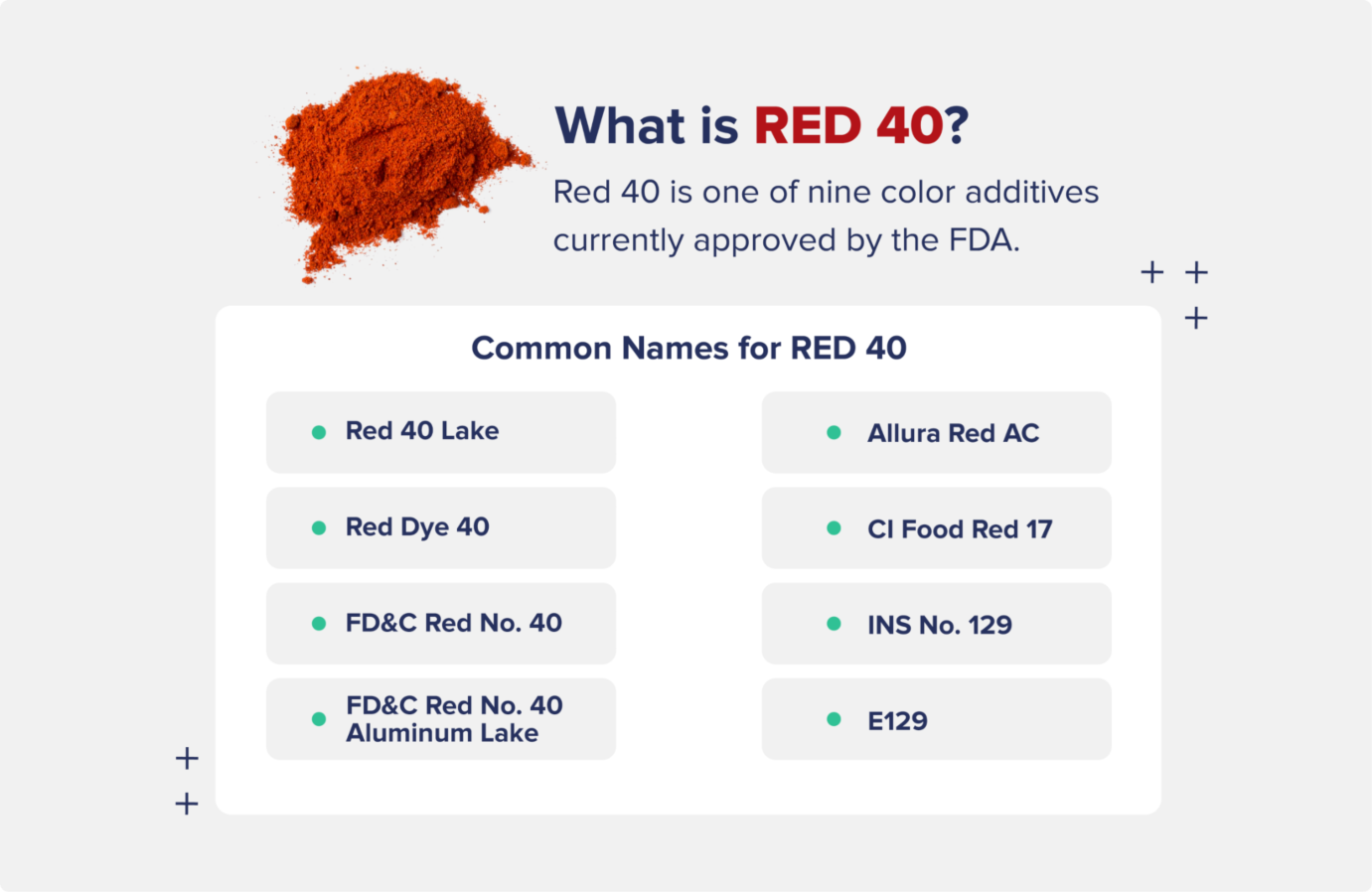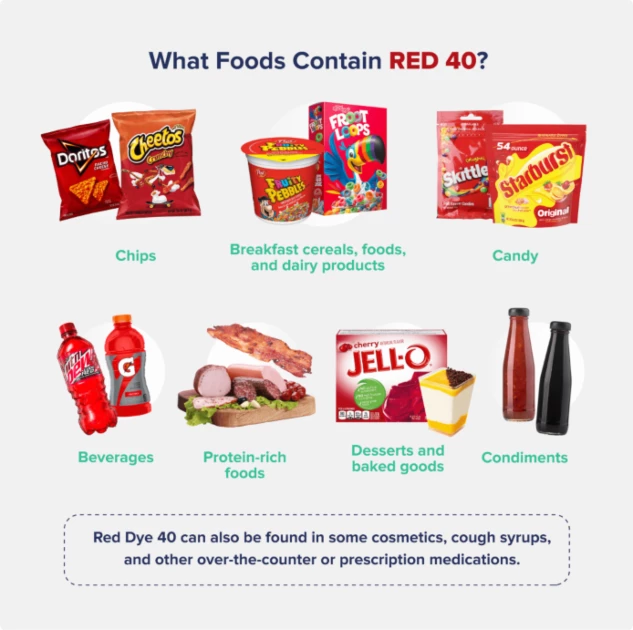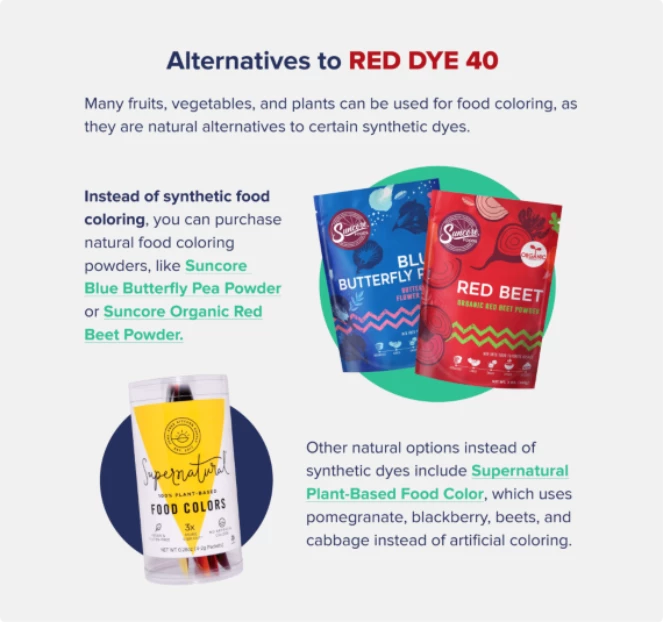Talk to a Registered Dietitian and use INSIDER20 for 20% off!
Talk to a real Dietitian for only $99: Schedule Now
This post contains links through which we may earn a small commission should you make a purchase from a brand. This in no way affects our ability to objectively critique the products and brands we review.
Evidence Based Research To fulfill our commitment to bringing our audience accurate and insightful content, our expert writers and medical reviewers rely on carefully curated research.
Read Our Editorial Policy
From cherry popsicles and Skittles to Cheetos and Doritos, red food dye is ubiquitous in the snack and processed food aisles.
While it can sometimes be hard to discern which foods use food dye, a good rule of thumb is if it stains your mouth or fingers, it’s typically artificial coloring (except for beets—you’re all good there).
But some food products have artificial coloring added even without causing the unnatural, almost-neon-like coloring—for example, did you know that some food manufacturers add Red Dye 40 to smoked salmon, Yellow #5 to pickles, or Blue #1 to canned peas?
Although Red Dye 40 is approved by the Food and Drug Administration (FDA) and the European Union (EU), many people wonder if this food dye is actually safe to eat—let’s find out.

Red 40 (also known as Red Dye 40) is one of nine color additives currently approved by the FDA—and it’s one of the most commonly found and consumed synthetic food colors in the American food supply.
You may also see Red 40 listed on food labels as:
Synthetic food dyes, including Red Dye 40, were originally derived from coal tar—now, they are made from petroleum or crude oil and mixed with various chemicals.
Some of the Red Dye 40 ingredients include benzidine, 4-aminobiphenyl, and p-cresidine, which has been classified by the Department of Health and Human Services National Toxicology Program as carcinogenic in animals and “reasonably anticipated to be a human carcinogen.”
Although each food dye is rigorously tested and undergoes FDA certification every time a new batch is produced, some people and public health groups are rightfully concerned about what these dyes are made out of and how these trace amounts of petroleum may affect the body.

Red Dye 40 is typically only found in processed foods and/or ready-made snacks. While this is not an exhaustive list, some of these foods and drinks include:
Red Dye 40 can also be found in some cosmetics, cough syrups, and other over-the-counter or prescription medications.
More and more research and anecdotal reports are coming out suggesting that Red Dye 40 can affect ADHD symptoms in children, migraines, and inflammatory bowel disease—let’s take a closer look at the data.
One of the most researched—and controversial—side effects of Red Dye 40 is its connection with ADHD symptoms and behavioral issues in children.
While the FDA’s Food Advisory Committee published a document in 2011 determining that there was no causal link between artificial food colors and ADHD symptoms, other studies have said otherwise.
For example, a 2015 meta-analysis concluded that 8% of children with ADHD have exacerbated hyperactivity symptoms after consuming artificial food dyes.
While that is not a huge number, many people with ADHD (or parents of children with ADHD) would agree that any reduction in symptoms is beneficial.
The authors of the meta-analysis also state that approximately 30% of children with ADHD are responsive to synthetic food dye elimination diets, meaning their symptoms improve.
Notably, the European Union requires a warning on food labels that contain Red Dye 40 (in addition to Yellow #5 and Yellow #6), stating that the dyes may have adverse effects on activity and attention in children.
The Food and Drug Administration does not require any warning labels about potential adverse effects of food dyes to be listed on U.S. foods containing Red Dye 40.
Despite upwards of 40 years of controversial opinions on the topic, we still don’t have conclusive evidence of whether or not artificial food dyes like Red 40 affect ADHD or cause adverse behavioral effects.
However, the benefits of eliminating food dyes seem to outweigh the potential risks of consuming them, leading many parents to limit or avoid Red 40-containing foods in their children’s diets.
Although based mainly on anecdotal evidence, food dyes like Red 40 are thought to trigger headaches or migraines in some people, possibly due to an allergic reaction, intolerance, or sensitivity to food dyes.
Someone with an allergy or intolerance to Red 40 may also experience nausea, vomiting, or dizziness.
Recent research published in Nature Communications found a link between synthetic food dye (Allura Red AC) consumption and the risk of developing inflammatory bowel disease (IBD) in mice.
The study found that mice who were continually exposed to Red 40 had increased gut inflammation and a worsening of ulcerative-colitis-related symptoms.
While these results have not been replicated in humans, if you notice any digestive symptoms after eating certain synthetic dyes like Red Dye 40, try eliminating them from your diet and see if you feel better.
As mentioned, p-cresidine—used in the production of Red Dye 40—has been classified as carcinogenic in animals, and researchers believe it is reasonably anticipated to be a human carcinogen.
Other research, like this 2012 review published in the International Journal of Occupational and Environmental Health, concluded that Red 40, Yellow #5, and Yellow #6 have all been found to be contaminated with carcinogens.
One of these carcinogenic compounds is benzidine, which has been linked to an increased risk of bladder cancer in humans who were occupationally exposed to the chemical.
However, in declaring its safety, the FDA has decided that the amounts of chemicals like benzidine and p-cresidine used in the food-dye-manufacturing process are not at high enough doses to raise concerns about their cancer-causing effects.
According to the Food and Drug Administration, Red Dye 40 and other synthetic food dyes are safe for consumption.
However, other research has shown that Red Dye 40 may increase hyperactivity and attention-related symptoms in children with ADHD.
Red Dye 40 may also cause gut inflammation, migraines, or allergic reactions in some people.
Red Dye 40 is legal because the FDA has deemed that the amounts used in dairy products and other foods are not high enough to cause adverse side effects or reactions in humans.
Red Dye 40 may cause allergic reactions in some people, including headaches or migraines, nausea, vomiting, or dizziness.
The majority of foods that contain Red Dye 40 are not healthy to begin with—whether or not they contain synthetic food dye or other artificial colors—so it’s wise to limit these in the diet anyway.
These foods and beverages include many processed snacks, breakfast cereals, colored dairy products, candy, baked goods, desserts, and drinks, such as Skittles, Starburst, Gatorade, Doritos, Cheetos, Pop-Tarts, Trix, Fruity Pebbles, popsicles, and pretty much anything with an unnatural-looking red, orange, or purple hue.
However, some foods contain Red Dye 40 that you may not suspect, like some brands of ketchup, barbecue sauce, pickles, relish, smoked salmon, salmon, ham, sausages, and bacon.
If you’re unsure, check the back of the package and read the ingredient list on the food labels.
Many fruits, vegetables, and plants can be used for natural colors, as they are natural alternatives to certain synthetic dyes.
These include carrots, turmeric, matcha, beets, tomato, blueberries, sweet potato, paprika, saffron, strawberries, raspberries, cabbage, spinach, and tea.
Instead of synthetic food coloring, you can purchase natural food coloring powders, like Suncore Blue Butterfly Pea Powder or Suncore Organic Red Beet Powder.
Other natural options instead of synthetic dyes include Supernatural Plant-Based Food Color, which uses pomegranate, blackberry, beets, and cabbage instead of artificial color.

While the research on Red Dye 40 (and other synthetic dyes or food additives) and certain health risks is inconclusive, some studies have shown a link between artificial food dye consumption and increased hyperactivity, worsening of behavioral conditions, and other mental health symptoms in children with ADHD.
Other research in animals has proposed that Red Dye 40 can increase the risk of inflammatory bowel disease, while other studies show that some of the chemicals used in making Red Dye 40 (and other synthetic food dyes) are carcinogenic.
Although we certainly need more research in humans to prove these links between the color additive and health concerns, it’s better to steer clear of artificial food colors/synthetic dyes in your diet anyway, as they tend to be highly processed and loaded with sugar, seed oils, and refined carbohydrates.